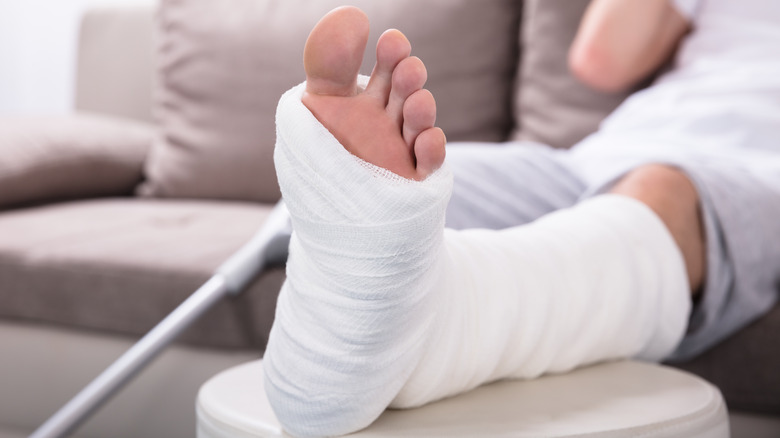Are Broken Bones More Likely To Be Broken Again?
If you've ever broken a bone, maybe you've wondered how exactly the body goes about working its magic to make you good as new again. Well, wonder no more.
According to Hackensack Meridian Health, the first step that takes place is a blood clot forms at the point of injury. In the following days, a soft callus begins to form, which progressively becomes more solid with the addition of calcium deposits. Otherwise known as the reactive phase, this process takes place over the course of roughly two days, reports Ortho Arizona. Next comes the reparative phase, in which the membrane over the break site forms into bone and cartilage and begins to fill in the space between the two separated parts of the bone. This process lasts approximately two to three weeks. Finally, we hit the remodeling phase. This is when the newly formed bone progressively turns into permanent bone matter. However, the length of this phase can vary and can take anywhere from weeks to years.
After you've made a full recovery, you may be asking, how reliable is your new bone? Is it possible that previously-broken bones are more prone to breaking yet again?
Tips for keeping bones in tip-top shape
Interestingly, Dr. Terry D. Amaral, director of pediatric orthopedic surgery at Montefiore Medical Center tells The New York Times that for a period of time, the surrounding uninjured bone is actually weaker than the fracture site. The reason being, the cast we wear as our body undergoes the healing process keeps the bone protected, but unused. "The area that's healing is undergoing rapid mineralization, but because you can't use it, the rest of the bone is demineralized," Dr. Amaral explains. Once the bone fully heals, however, experts state that your previously-broken bone is no more vulnerable to breakage than any of your other bones.
Even so, this doesn't mean that it isn't possible for the same fracture to occur again, cautions Ortho Arizona. Even if not in the exact same spot, The New York Times reports that some individuals, such as older adults who tend to be more prone to osteoporosis, are at higher risk for subsequent bone breaks following a first-time fracture. To help safeguard against a broken bone, Hackensack Meridian Health suggests regularly eating food items packed with vitamin D and calcium to keep our bones strong. Additionally, stair-climbing, running, walking, and weight-lifting are among some of the most beneficial forms of physical activity for our bones. On the other hand, smoking and alcohol consumption can make one more susceptible to osteoporosis. Therefore, it's advised that individuals refrain from smoking altogether and keep alcohol consumption at a minimum.


